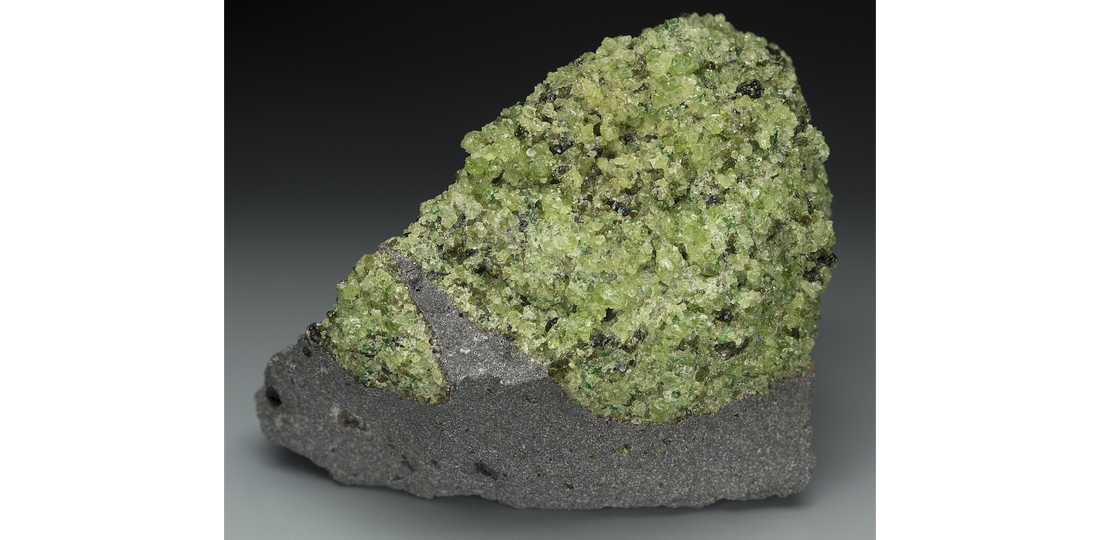
The Perfection of Peridot, part 4: Provenance and Pedigree
Share
Although peridot is found all over the world, there are some locations which produce stones in significantly higher quantities and yield significantly larger crystals than the rest. For a time, places like southwestern China, the Pyin-Oo-Lwin District of Myanmar (a.k.a. “Burma”), and the southwestern United States were some of the most important sources of peridot for the jewellery industry. More recently, high quality peridot gems have been exported from a region in central Asia which covers parts of both northern Pakistan and northern Afghanistan, with the portions of this deposit found on the Pakistani side of the border being most famous for the large and richly saturated gems which they have yielded. Other less significant sources for peridot gemstones include Mexico, Australia, Tanzania, Kenya, Sri Lanka, and Vietnam.

Predictably, the host rocks containing forsterite crystals best suited for use as peridot typically are mafic or ultramafic rocks, which are petrological formations containing high concentrations of iron and magnesium; it is through volcanic activity that most of these peridot bearing rocks form. The shallow portions of the upper mantle contain large amounts of forsterite and pyroxenes, with forsterite being the most abundant mineral found in this region. The composition of the upper mantle combined with the high melting point of forsterite provides ideal conditions by which new peridot material can be brought into the crust; as magma cools forsterite crystals are among the first to precipitate out of solution, often followed by pyroxene minerals, which typically leads to the cumulate formation of granular rocks high in olivine content such as dunite (a.k.a. “olivinite”) and peridotite. Fayalite crystals can also be concentrated in the crust through the same process, but these form in much lower proportions than forsterite crystals, and high purity fayalite is quite rare. Under certain conditions, crystals of forsterite may form in the crust as a result of metamorphic activity, such as the metamorphosis of dolomite and magnesium rich limestones into dolomitic marble, or in some cases within metamorphosed serpentines, but these occurrences are less common. Despite the ongoing arrival of olivine crystals at minable depths, only a small percentage of these mineral formations bear material suitable for use as peridot gemstones, and an even smaller percentage survive long enough to be unearthed by human beings before undergoing some degradation due to the rapid rate at which olivine crystals weather under moist conditions present in the crust and on the Earth’s surface; in the presence of water, olivine may be rapidly altered into one component of the rock iddingsite, with smaller crystal grains having the potential to completely weather away in just a few years. The relatively easy weathering of olivine makes large high quality peridot crystals a truly rare occurrence for a mineral which represents such a significant part of the planet’s composition.

Interestingly, peridot is one of the few gem minerals that is not unique to planet Earth. Olivine crystals are part of the mineralized mass found in stony materials beyond the limits of the Third Planet, and it is partially for this reason that such a large proportion of olivine can be found as a component of Earth’s rocks; when the planet was formed over four billion years ago, large quantities of dust and small stony bodies present in the solar system combined with one another to form a young planet Earth. At the time, there were approximately 250 different mineral species contained within these primordial planetary building blocks, including olivine. Today, there are over 5000 known mineral species that have been characterised by scientists, but even with the dynamic alteration of the original 250 species into the vast landscape of minerals seen today, olivines have remained a key part of the planet’s constitution. Intriguingly, extraterrestrial materials that contain olivine crystals can still be found on Earth, specifically in the form of pallasite meteorites that arrived after the planet’s turbulent genesis. Pallasites are one of three major meteorite classes, with the others being chondrites (i.e. stony meteorites) and iron meteorites; pallasite meteorites can be described as a type of intermediary between the other two major meteorite classes, with their mass being composed of both metallic and stony materials. Among mineral collectors and meteorite enthusiasts, pallasites are most famous for the beautiful patterning they sometimes display which features transparent olivine crystals intermingled in a matrix of the meteoric two phase iron-nickel alloy that makes up the metallic portion of these meteorites. Although olivine crystals found in pallasites are almost never gem grade and typically have a less attractive colour than that of terrestrial peridot due to their higher iron content, there are rare cases where peridot gemstones may be cut from the meteoric olivine found in pallasites. Such gems are seldom found on the open market and are typically of low quality, but they symbolise the cosmic importance of olivine as a mineral and in some ways reflect the significance of terrestrial peridot as a gemstone born of ancient Earth.


Still an important geological constituent of the planet and a significant player in the contemporary jewellery market, the arrival of peridot gemstones in the human world began thousands of years ago. In the next part of this series, learn about the oldest peridot mines known in written history.
© Yaĝé Enigmus






